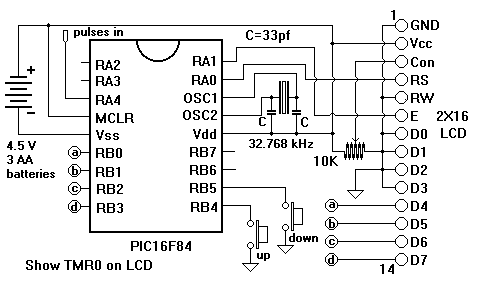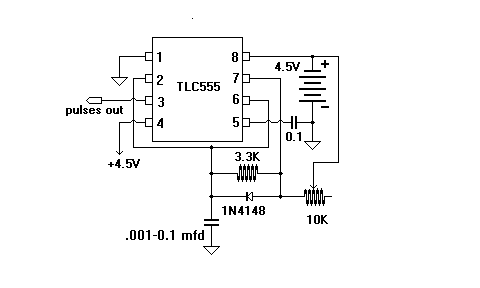

Also:
;-------------------------------------------------------------------------;
; SHOTMR0.ASM Show TMR0 in decimal on LCD after counting 1 second ;
;-------------------------------------------------------------------------;
LIST P=16F84 ; 16F84 Runs at 4 MHz
INCLUDE "p16f84.inc"
__CONFIG _PWRTE_ON & _LP_OSC & _WDT_OFF ; uses 32.768 kHz crystal
ERRORLEVEL -224 ; supress annoying message because of tris
ERRORLEVEL -302 ; supress message because of page change
; Define Information
#DEFINE RS PORTA, 0 ; RA0 is RS line of LCD
#DEFINE E PORTA, 1 ; RA1 is E line of LCD
; RB0-RB3 are D4-D7 of LCD
; Macro
EStrobe MACRO ; Strobe the "E" Bit
bsf E
bcf E
ENDM
CBLOCK 0CH
Temp ; a temporary variable
count ; counter
precount ; holds value for prescalar
bin ; binary number to be converted to BCD
hundreds ; BCD hundreds result
tens_and_ones ; BCD tens and ones result
ENDC
ORG 0 ; start at location 0
goto main ; jump over to main routine
;-------------------------------------------------------------------------;
; Data for message to be output ;
;-------------------------------------------------------------------------;
shomsg: ; Message to Output
addwf PCL, f ; Output the Characters
m0 dt "TMR0 Value:", 0
m1 dt "Multiply by:", 0
;-------------------------------------------------------------------------;
; Ratios of Prescaler ;
;-------------------------------------------------------------------------;
preratio:
addwf PCL, f ; select offset using W
dt D'2',D'4',D'8',D'16',D'32',D'64',D'128'
;-------------------------------------------------------------------------;
; Initialize the ports ;
;-------------------------------------------------------------------------;
Init:
clrf PORTA
clrf PORTB
movlw B'00010000' ; RA4 input, others outputs
tris PORTA
movlw B'00110000' ; RB4, RB5 input, others outputs
tris PORTB
movlw B'00100001' ; pull-ups enabled
; prescaler assigned to RA4
; prescaler set to 1:4
option
clrf precount
return
;-------------------------------------------------------------------------;
; Initialize the LCD ;
;-------------------------------------------------------------------------;
initlcd:
movlw D'40'
call nmsec ; Wait 40 msecs before Reset
bcf RS ; send an 8 bit instruction
movlw 0x03 ; Reset Command
call NybbleOut ; Send the Nybble
call Dlay5 ; Wait 5 msecs before Sending Again
EStrobe
nop
nop ; Wait 244 usecs before Sending the Second Time
EStrobe
nop
nop ; Wait 244 usecs before Sending the Third Time
bcf RS ; send an 8 bit instruction
movlw 0x02 ; Set 4 Bit Mode
call NybbleOut
nop
nop
movlw 0x028 ; 4 bit, 2 Line, 5x7 font
call SendINS
movlw 0x010 ; display shift off
call SendINS
movlw 0x001 ; Clear the Display RAM
call SendINS
call Dlay5 ; Note, Can take up to 4.1 msecs
movlw 0x006 ; increment cursor
call SendINS
movlw 0x00C ; display on cursor off
call SendINS
return
;-------------------------------------------------------------------------;
; Send the character in W out to the LCD ;
;-------------------------------------------------------------------------;
SendASCII
addlw '0' ; Send nbr as ASCII character
SendCHAR ; Send the Character to the LCD
movwf Temp ; Save the Temporary Value
swapf Temp, w ; Send the High Nybble
bsf RS ; RS = 1
call NybbleOut
movf Temp, w ; Send the Low Nybble
bsf RS
call NybbleOut
return
;-------------------------------------------------------------------------;
; Send an instruction in W out to the LCD ;
;-------------------------------------------------------------------------;
SendINS ; Send the Instruction to the LCD
movwf Temp ; Save the Temporary Value
swapf Temp, w ; Send the High Nybble
bcf RS ; RS = 0
call NybbleOut
movf Temp, w ; Send the Low Nybble
bcf RS
call NybbleOut
return
;-------------------------------------------------------------------------;
; Send the nibble in W out to the LCD ;
;-------------------------------------------------------------------------;
NybbleOut ; Send a Nybble to the LCD
movwf PORTB
EStrobe ; Strobe out the LCD Data
nop
nop
return
;-------------------------------------------------------------------------;
; Output the message on the LCD ;
;-------------------------------------------------------------------------;
OutMessage:
movwf FSR ; Point at first letter
OutLoop:
movf FSR, w ; Get pointer into W
incf FSR, f ; Set up for next letter
call shomsg ; Get character to output
iorlw 0 ; At the End of the Message?
btfsc STATUS, Z ; Skip if not at end
return ; Yes - Equal to Zero
call SendCHAR ; Output the ASCII Character
goto OutLoop ; Get the next character
;-------------------------------------------------------------------------;
; Change binary nbr in bin to BCD ;
;-------------------------------------------------------------------------;
binary_to_bcd ; by Scott Dattalo
clrf hundreds
swapf bin, W
addwf bin, W
andlw B'00001111'
skpndc
addlw 0x16
skpndc
addlw 0x06
addlw 0x06
skpdc
addlw -0x06
btfsc bin,4
addlw 0x16 - 1 + 0x6
skpdc
addlw -0x06
btfsc bin,5
addlw 0x30
btfsc bin, 6
addlw 0x60
btfsc bin,7
addlw 0x20
addlw 0x60
rlf hundreds, f
btfss hundreds, 0
addlw -0x60
movwf tens_and_ones
btfsc bin,7
incf hundreds, f
return
;-----------------------------------------------------------------------;
; Delay routine ;
;-----------------------------------------------------------------------;
msec250 movlw 0 ; 250 msec delay (adjusted to try and
; allow for 2.5% low loop time)
goto $+2
Dlay5 movlw 5 ; delay for 5 milliseconds
nmsec: ; delay for # msec in W on entry
nop ; each nop is 0.122 milliseconds
nop
nop ; each total loop is 8 X 0.122 = 0.976 msec
nop
addlw H'FF' ; same as subtracting 1 from W
btfss STATUS, Z ; skip if result is zero
goto nmsec ; this is 2 X 0.122 msec
return ; back to calling point
;-------------------------------------------------------------------------;
; Display binary value in W in decimal ; ;
;-------------------------------------------------------------------------;
DispDec
movwf bin
call binary_to_bcd
movf hundreds, W
call SendASCII
swapf tens_and_ones, W
andlw H'F'
call SendASCII
movf tens_and_ones, W
andlw H'F'
call SendASCII
return
;-------------------------------------------------------------------------;
; Return the prescalar ratio setting in W ;
;-------------------------------------------------------------------------;
getpre:
bsf STATUS, RP0 ; change to page 1
movf OPTION_REG, W ; get OPTION register
bcf STATUS, RP0 ; back to page 0
andlw 7 ; get 1st 3 bits in W
return
;-------------------------------------------------------------------------;
; Check pushbuttons and increment or decrement prescalar ;
;-------------------------------------------------------------------------;
ckbuttons:
call getpre ; get prescalar ratio # in Temp
movwf Temp
btfss PORTB, 4 ; Skip if button on RB4 up
goto preup ; increment prescalar
btfss PORTB, 5 ; Skip if button on RB5 up
goto predown ; decrement prescalar
return ; no buttons pressed, return
preup:
incf Temp, f ; up one
btfsc Temp, 3 ; if reach 8, go back to zero
clrf Temp
goto newpre ; and fix new ratio
predown:
decf Temp, f ; down one
movlw H'FF' ; check for underflow
subwf Temp, W
btfss STATUS, Z ; skip if underflow
goto newpre ; and fix new ratio
movlw 7 ; reset to 7
movwf Temp
newpre
bsf STATUS, RP0 ; change to page 1
movlw B'11111000' ; mask out low three bits
andwf OPTION_REG, W ; result in W
bcf STATUS, RP0 ; back to page 0
iorwf Temp, W ; add in new prescalar ratio #
option ; update OPTION
return
;-------------------------------------------------------------------------;
; The Main routine ;
;-------------------------------------------------------------------------;
main:
call Init ; initialize ports, set up timer
call initlcd ; initialize the LCD
movlw H'80' ; position at 1st line column 0
call SendINS
movlw m0 -2 ; send 'TMR0 Value:' message
call OutMessage
movlw H'C0'
call SendINS ; position at 2nd line column 0
movlw m1 -2 ; send 'Multiply by:' message
call OutMessage
sholoop:
call ckbuttons ; update prescalar if buttons pushed
movlw H'CD' ; position at 2nd line column 13
call SendINS
call getpre ; get prescalar ratio # in binary
call preratio ; change to prescalar ratio
call DispDec ; put it on LCD
movlw H'8C' ; position at 1st line column 12
call SendINS
bcf INTCON, T0IF ; clear timer zero interrupt flag
clrf TMR0 ; zero TMR0
call msec250 ; wait a total of one second
call msec250
call msec250
call msec250
movf TMR0, W ; retrieve timer zero
btfsc INTCON, T0IF ; check if timer overflowed
goto overload ; yes, display 'OVR'
call DispDec ; display TMR0 value
goto sholoop ; repeat forever
overload
movlw 'O' ; output 'OVR'
call SendCHAR
movlw 'V'
call SendCHAR
movlw 'R'
call SendCHAR
goto sholoop ; and continue
end
Timer 0 can be set up to count pulses entering the pic on RA4. You can make
a simple 555 circuit as shown below to generate the pulses.

TMR0 can hold values only up to 255. What if the frequency is higher than this? The answer lies in the prescalar which is inserted between RA4 and TMR0 and provides division of the count by 2,4,8...256 depending on the lowest three bits in the OPTION register, (PS0-PS2). Changing this to 1:256 allows us to count frequency up through 64K. Pushbuttons are used to change the prescalar and the multiplying factor is shown on the display along with TMR0.
Since TMR0 is used to do the counting, it can't be used to provide a one second interval at the same time. We must rely on instruction time counting to get one second. The routine nmsec is not accurate. 1 millisecond turns out to be closer to 975 microseconds, 2.5 % low. We try to allow for this when calling msec250 by counting more than 250 loops. The maximum we can count using one byte is 256 by setting the intial value to 0. Actually this turns out to be pretty close to the value we need, (maybe a little long because of the calls, returns and other overhead). You might also try D'255'.
If the message 'OVR' is displayed instead of a value for TMR0, it means that timer 0 has overflowed and the prescalar must be set to a higher ratio. The button on RB4 moves the ratio up and the one on RB5 moves it down. No debouncing is necessary for these buttons because they are checked only once each second. It also means you have to hold the button down for a while to make it work. Multiply the value of TMR0 by the multiplier indicated to get the actual frequency.
There is a method to get higher precision, but it is a little involved. The residual count actually appears in the prescalar when counting is complete. The problem is that the prescalar can't be read directly as a register. What is usually done is to use another pin to pulse RA4, keeping track of the number of pulses until TMR0 overflows. Subtract this number from 256 and the result is the contents of the prescalar when counting was first terminated. The total count is then the ratio times TMR0 plus this residual. For an example of this, go to http://www.piclist.com/faq and click on 'PICList projects' and the 'Weeder Frequency Counter PIC16F84 port'.
The frequency of the 555 oscillator is determined by the resistors and capacitor used. This suggests that since we can measure frequency, we can measure an unknown capacitance if the reistance is known or vice-versa. Also, any property which varies one of these can be measured if we know how this property makes the frequency change. Think of some properties you might like to measure with this setup.
Comments:
| file: /Techref/piclist/cheapic/shotmr0.htm, 15KB, , updated: 2011/1/20 09:20, local time: 2025/10/24 15:12,
owner: kentken-HotPOP-,
216.73.216.22,10-3-83-201:LOG IN
|
| ©2025 These pages are served without commercial sponsorship. (No popup ads, etc...).Bandwidth abuse increases hosting cost forcing sponsorship or shutdown. This server aggressively defends against automated copying for any reason including offline viewing, duplication, etc... Please respect this requirement and DO NOT RIP THIS SITE. Questions? <A HREF="http://www.piclist.com/techref/piclist/cheapic/shotmr0.htm"> Show Count of TMR0 on LCD</A> |
| Did you find what you needed? |
|
o List host: MIT, Site host massmind.org, Top posters @none found - Page Editors: James Newton, David Cary, and YOU! * Roman Black of Black Robotics donates from sales of Linistep stepper controller kits. * Ashley Roll of Digital Nemesis donates from sales of RCL-1 RS232 to TTL converters. * Monthly Subscribers: Gregg Rew. on-going support is MOST appreciated! * Contributors: Richard Seriani, Sr. |
Welcome to www.piclist.com! |
.